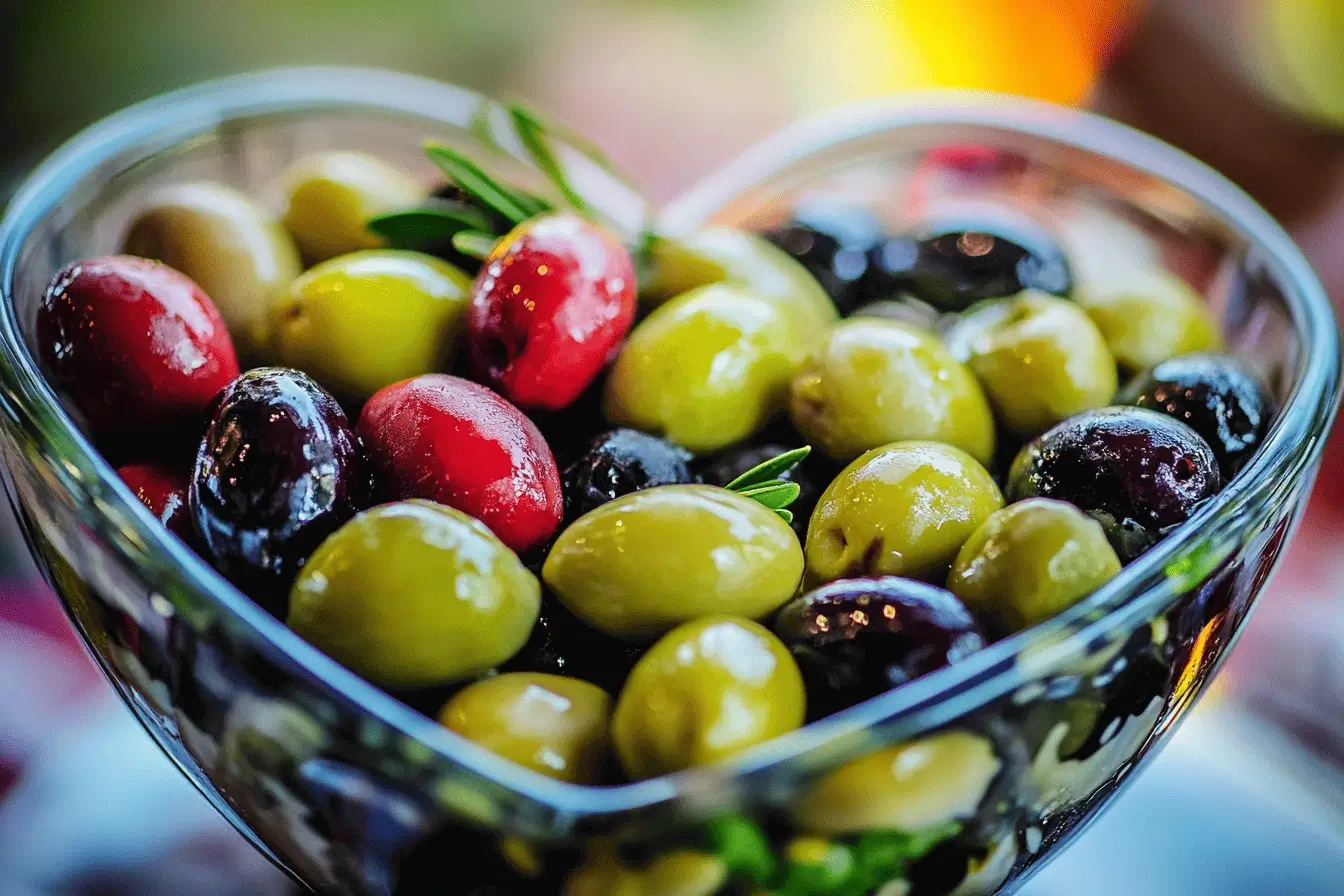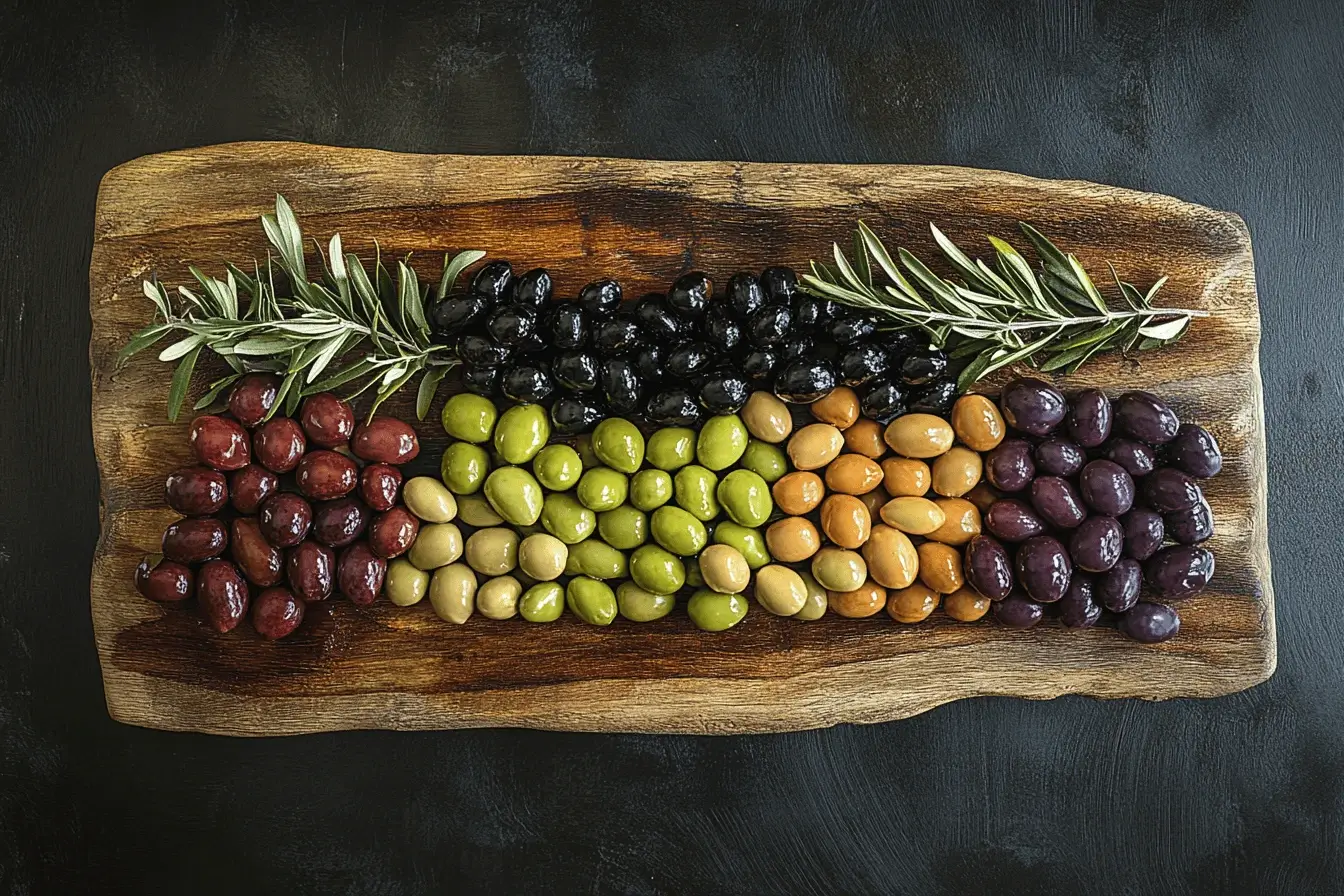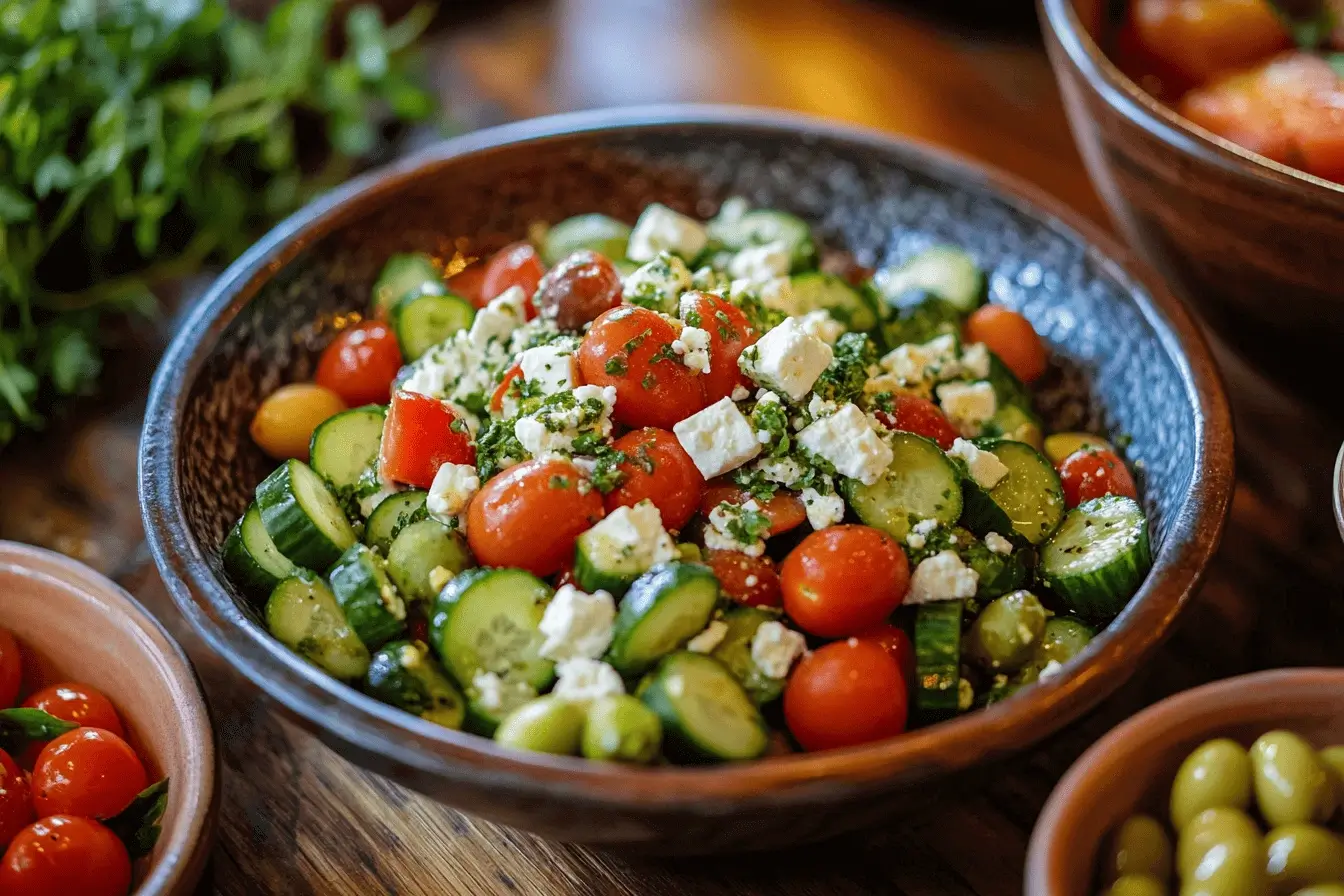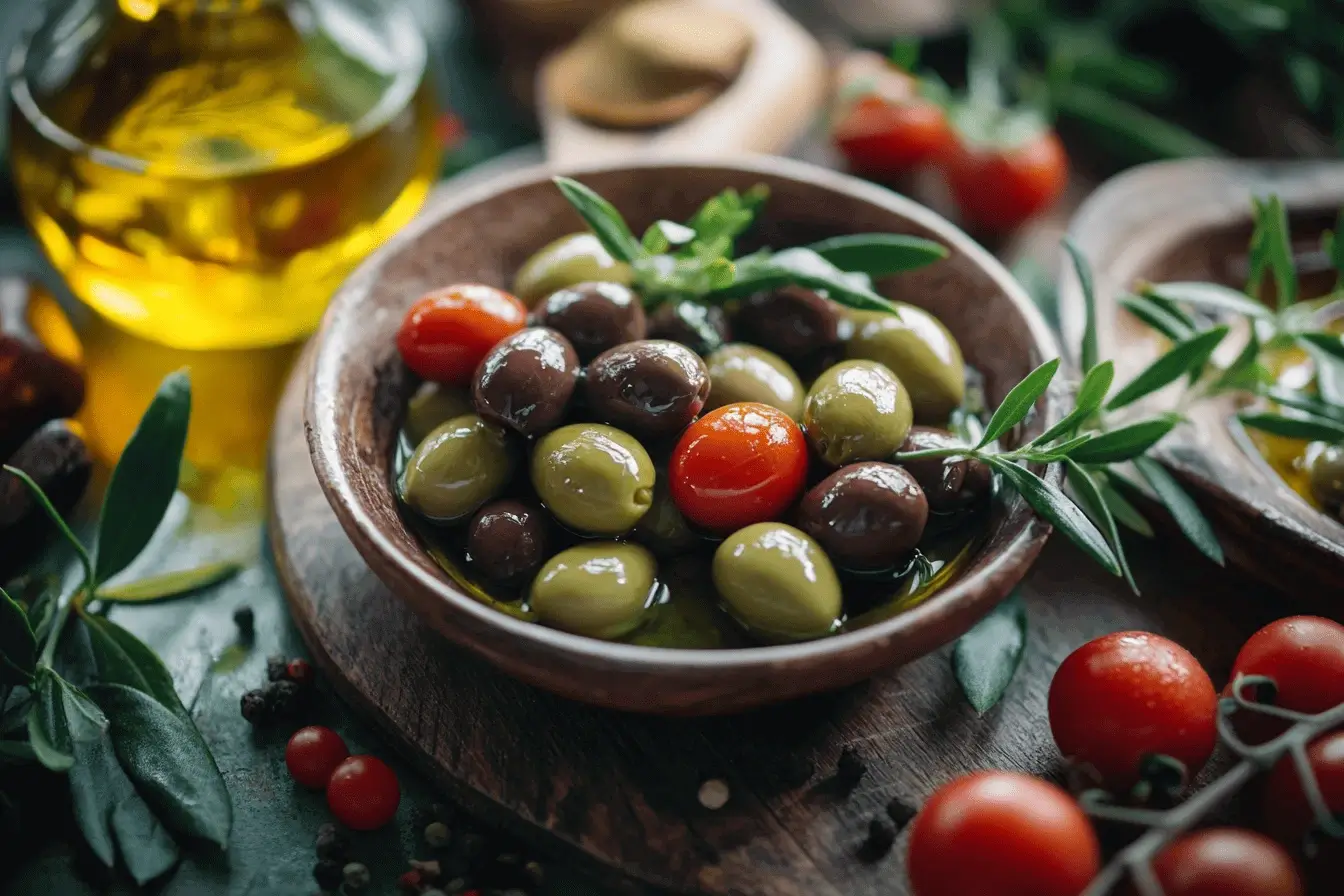How Many Olives Should I Eat a Day? Health Benefits Explained
Olives are a delicious and nutritious addition to many diets, but how many olives should you eat a day to reap the benefits without going overboard? In this article, we will answer that question while exploring the many health advantages of including olives in your daily meals. Furthermore, we’ll dive into portion control, the nutritional profile of olives, and ways to incorporate them into various dishes.
Why You Should Include Olives in Your Diet
Olives are not only flavorful but also packed with essential nutrients that contribute to a healthy lifestyle. When consumed in moderation, they can provide a wide array of health benefits. Incorporating olives into meals like green olive dinner recipes can help you achieve this balance. But how many olives should you eat a day to maximize these advantages?
Health Benefits of Eating Olives
First and foremost, olives are rich in monounsaturated fats—healthy fats that help lower bad cholesterol (LDL) and improve heart health. Consuming the recommended amount of olives daily can help reduce your risk of heart disease, one of the leading causes of death worldwide. In addition, olives contain antioxidants, such as vitamin E and polyphenols, which help protect your cells from oxidative stress and inflammation. Similar to the effects of cranberry juice on your system, the antioxidant properties of olives contribute significantly to better health.

But how many olives should you eat a day to enjoy these benefits? While this depends on individual dietary needs, generally, consuming around 6 to 10 olives per day is sufficient to give you a healthy dose of fats, fiber, and antioxidants without excessive calories or sodium.
Who Will Benefit from Eating Olives?
- Health-conscious individuals: If you’re trying to eat heart-healthy foods, olives are a great addition to your diet.
- Weight-conscious people: Olives can be an excellent low-calorie, flavorful snack that helps curb hunger.
- Busy professionals: For those constantly on the go, olives provide a quick and easy snack option rich in nutrients.
- Food enthusiasts: Olives are a staple in Mediterranean cuisine and can elevate various dishes.
In conclusion, understanding how many olives you should eat a day is essential for balancing the nutritional benefits and avoiding excessive sodium intake. Next, let’s explore the nutritional content and recommended portion sizes for optimal health.
How Many Olives Should You Eat a Day?
When considering how many olives you should eat a day, it’s important to balance their nutritional benefits with their sodium content. Including olives in dishes like Mediterranean salad recipes offers a flavorful and healthy way to moderate sodium intake. Olives are typically preserved in brine, which makes them high in sodium. However, moderation allows you to enjoy their health benefits without negatively affecting your diet.

Recommended Daily Olive Intake
So, how many olives should you eat a day? Most dietitians recommend consuming 6 to 10 olives per day. This portion provides approximately 40-50 calories, making it an ideal snack or addition to your meals without overloading on calories. Moreover, this portion contains roughly 4-5 grams of fat, primarily healthy fats, which are beneficial for heart health.
The Role of Sodium in Your Diet
While olives are rich in healthy fats, they can also be high in sodium due to the brining process. As a result, it’s important to pay attention to sodium intake, especially for those with high blood pressure or other health concerns. The recommended limit for sodium consumption is about 2,300 milligrams per day, and a serving of 10 olives contains around 200-300 milligrams of sodium. Thus, being mindful of how many olives you eat a day can help you stay within this limit.
Portion Control
Even though olives are a healthy choice, overconsumption can lead to excessive calorie and sodium intake. To avoid this, try to stick to the recommended 6-10 olives a day. Moreover, if you are concerned about sodium, consider rinsing your olives before eating them, or look for low-sodium options in the store.
In short, keeping track of how many olives you eat a day is crucial for maintaining a balanced diet while enjoying their numerous benefits.
Nutritional Breakdown of Olives
When deciding how many olives you should eat a day, it’s helpful to know what nutrients they provide. Although olives are small, they pack a nutritional punch and contain a wealth of vitamins, minerals, and healthy fats. However, it’s also important to monitor sodium content, especially when eating olives regularly.
What Do You Get from 10 Olives?
Here is a general nutritional breakdown of 10 small to medium-sized olives:
| Nutrient | Amount per 10 Olives |
|---|---|
| Calories | 40-50 |
| Fat | 4-5g (mostly monounsaturated) |
| Sodium | 200-300mg |
| Fiber | 1-2g |
| Vitamin E | 10% of Daily Value (DV) |
| Iron | 5% of DV |
| Calcium | 2-3% of DV |
Why These Nutrients Matter
- Monounsaturated fats: These healthy fats help lower bad cholesterol and are associated with a reduced risk of heart disease.
- Antioxidants: Olives are rich in polyphenols and vitamin E, which fight inflammation and protect against cellular damage.
- Fiber: Even though the fiber content in olives is modest, it contributes to digestive health.
Thus, when you know how many olives you should eat a day, you can confidently incorporate them into your diet, knowing you’re getting a host of health benefits.
Different Types of Olives and Their Nutritional Value
Kalamata Olives, known for their dark purple color and rich, fruity flavor, are common in Greek dishes. They tend to be larger and richer in polyphenols, which help fight inflammation, similar to other superfoods like pineapple juice that boost your health. The variety of olives available gives you the flexibility to choose which best fits your meals.

Common Olive Varieties
- Kalamata Olives: Known for their dark purple color and rich, fruity flavor, these olives are common in Greek dishes. They tend to be larger and richer in polyphenols, which help fight inflammation.
- Green Olives: Picked before they fully ripen, green olives are firmer and slightly more bitter. They are often stuffed with ingredients like pimentos, garlic, or almonds, adding extra variety to your diet.
- Black Olives: These are ripened olives with a softer texture and a milder taste. While they contain less bitterness than green olives, they offer similar health benefits and can be used in a variety of dishes.
- Castelvetrano Olives: Known for their bright green color and mild, buttery flavor, these olives are often enjoyed as a snack or appetizer.
Choosing the Right Olives
Each variety of olive brings its unique flavor and health benefits. However, the question remains: how many olives should you eat a day? Regardless of the type, the answer is typically the same—around 6-10 olives per day for most people. This allows you to benefit from their nutrients while keeping your sodium intake in check.
Dietary Considerations
If you are on a low-sodium diet, it’s essential to be cautious of how many olives you eat a day. Choose low-sodium varieties, or consider rinsing olives before consuming them to reduce their salt content.
Step-by-Step Guide: How to Incorporate Olives into Your Daily Meals
When thinking about how many olives you should eat a day, consider using them as a flavor enhancer in cooked dishes. For example, green olive dinner dishes can add savory depth to meals such as pasta or stews. This helps you enjoy a delicious meal while staying within healthy limits for daily olive consumption.

1. Snack on Olives
A handful of olives makes a quick, satisfying snack. Eating 6-10 olives between meals can help curb hunger and provide a boost of healthy fats and antioxidants. To mix things up, pair your olives with a slice of cheese, whole-grain crackers, or nuts.
2. Add Olives to Salads
Olives add a burst of flavor to any salad. You can slice them and toss them into a Greek salad or add them to a pasta salad for a Mediterranean twist. Pair olives with ingredients like cucumbers, tomatoes, and feta cheese for a refreshing, healthy meal.
3. Make Olive Tapenade
Tapenade is a delicious olive spread made from blending olives with garlic, capers, olive oil, and lemon juice. Spread tapenade on whole-grain crackers, use it as a sandwich spread, or serve it as an appetizer at a party.
4. Add Olives to Hot Dishes
When thinking about how many olives you should eat a day, consider using them as a flavor enhancer in cooked dishes. Add them to pasta, rice dishes, or stews to create a savory depth of flavor. For example, olives are a key ingredient in puttanesca sauce, a tangy Italian pasta sauce that combines olives, capers, tomatoes, and anchovies.
In summary, knowing how many olives you should eat a day is just the first step. With these meal ideas, you can easily incorporate olives into your diet in a delicious and healthy way.
Tips for Balancing Olive Consumption with a Healthy Diet
Olives are a great addition to a balanced diet, but it’s essential to consume them in moderation. The following tips will help you enjoy olives without going overboard.
1. Be Mindful of Sodium
As mentioned earlier, olives are preserved in brine, making them high in sodium. To reduce your sodium intake, consider rinsing olives before eating them. Moreover, some brands offer low-sodium versions, which can be a better option for those monitoring their salt intake.
2. Pair Olives with Healthy Fats
Since olives are rich in monounsaturated fats, they pair well with other healthy fats like avocado or nuts. This can enhance their health benefits and make your meals more satisfying.
3. Pay Attention to Portion Sizes
Knowing how many olives you should eat a day helps you avoid overconsumption. Stick to the recommended serving size of 6-10 olives to enjoy their benefits without consuming too many calories or sodium.
4. Use Olives as a Substitute for Salt
Instead of adding salt to your dishes, use chopped olives to add a burst of flavor. This not only enhances the taste but also helps reduce your overall sodium consumption.
Variations and Dietary Modifications for Olive Lovers
For those with specific dietary preferences or restrictions, it’s easy to adjust how many olives you should eat a day and tailor the recipe accordingly.
Recipe Variations
- Spicy Olives: If you enjoy a little heat, marinate your olives with chili flakes or jalapeños for an extra kick.
- Herb-Infused Olives: Try marinating your olives in olive oil with rosemary, thyme, or garlic to create a rich, flavorful snack.
- Stuffed Olives: Add variety to your diet by opting for stuffed olives, such as those filled with almonds, blue cheese, or pimentos.
Dietary Adjustments
- Vegan and Plant-Based: Olives are naturally vegan, making them an excellent snack for plant-based eaters.
- Low-Carb or Keto: Since olives are low in carbs and high in healthy fats, they are perfect for those following a ketogenic diet.
- Gluten-Free: Olives are gluten-free, so they can be safely enjoyed by those with gluten intolerance or celiac disease.
No matter what dietary approach you follow, you can easily adjust how many olives you eat a day to fit your lifestyle.
Frequently Asked Questions (FAQs)
1. How many olives should I eat a day for weight loss?
When it comes to weight loss, olives can be a great snack. Eating around 6-10 olives per day provides healthy fats and fiber, helping you feel full without consuming too many calories.
2. Are there low-sodium olives available?
Yes, many brands offer low-sodium versions of olives. Additionally, you can rinse regular olives under water to reduce their salt content.
3. Can I eat olives on a ketogenic diet?
Absolutely! Olives are low in carbs and high in healthy fats, making them an ideal food for those following a ketogenic or low-carb diet.
4. Can I eat olives every day?
Yes, as long as you stick to the recommended portion size (6-10 olives per day), you can safely enjoy olives every day.
5. Can I use olive oil instead of whole olives?
Yes, olive oil offers many of the same health benefits as whole olives. Extra virgin olive oil, in particular, is rich in healthy fats and antioxidants.
Conclusion: How Many Olives Should You Eat a Day?
Incorporating olives into your diet can offer numerous health benefits, from improving heart health to providing essential nutrients like fiber and antioxidants. However, the key is moderation. So, how many olives should you eat a day? The recommended serving size is 6-10 olives per day, which allows you to enjoy their rich flavor and nutritional benefits without consuming too much sodium or calories.
Whether you enjoy them as a snack, in salads, or as part of a larger dish, olives are a versatile and healthy addition to any diet. With so many varieties to choose from, there’s no shortage of ways to enjoy them. Try incorporating olives into your meals today, and discover how this small but mighty fruit can enhance your health and well-being.
Call to Action
Do you have a favorite way to enjoy olives? Share your tips and recipes in the comments below! Don’t forget to share this article with your friends and family, and follow our blog for more delicious and nutritious recipe ideas.


